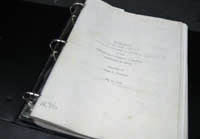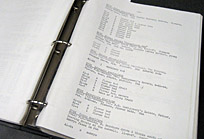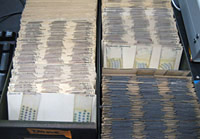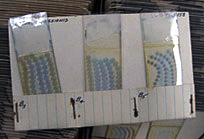About the Plant Anatomy Reference Collection
In 1942, after 50 years with the USDA, Walter T. Swingle retired to Miami and shortly afterward became the Consultant of Tropical Botany and Head of the Plant Research Laboratory at the University of Miami. While at UM, he began an ambitious project to build a reference collection of anatomical slides of economically important tropical crops and their relatives. In a letter to Dr. David Fairchild, Swingle stated that his goal was to make this collection the “best in the world” and “instantly available” to anyone working on tropical plants. He believed that the single greatest problem in tropical and subtropical agriculture was the lack of knowledge of the wild relatives of economically important species. A comprehensive collection of anatomical slides prepared from carefully verified specimens would, in Swingle's view, revolutionize the use of tropical plants by facilitating their identification using microscopic characteristics.
The Swingle Plant Anatomy Reference Collection has survived and is currently housed in the Whitlock lab at the University of Miami. The collection consists of over 26,000 glass microscope slides detailing the anatomy of flower buds, fruit, seeds, leaves, shoots, and roots of some 575 species from 68 families of plants. Most of these slides are sets of serial sections, or consecutive microscopic slices of a single plant structure. Over half of the slides are from species of Rutaceae, the family that includes citrus, reflecting Swingle’s interests and expertise. Mango and its relatives (Anacardiaceae), litchi (Sapindaceae), jute and kenaf (Malvaceae s.l.) are also well represented. The most common structures sectioned are flower buds that have historically been emphasized as a source of taxonomic characteristics. In the case of jute and kenaf, both important sources of commercial fibers, most of the sections are shoots from plants in experimental plots in Cuba collected in the 1950s.
Swingle succeeded with his first goal in that this collection is arguably the best representation of tropical plant anatomy in the world. However, it is not (or perhaps is no longer) a resource that Swingle envisioned as instantly available to all scientists, but rather appears to be long forgotten by the scientific community. One goal of the Digital Library Fellowship is to bring the Swingle Collection back into the scientific mainstream via the internet. Over 1700 digital micrographs have been taken from 384 specimens and are now available online. Although this represents only a small fraction of the collection, it provides a glimpse of the diversity of this extraordinary resource. Fortunately, one of Swingle’s assistants carefully prepared a type-written catalog to the entire collection. Anyone interested in exploring the complete holdings of the collection can now access the searchable electronic version of the catalog.
Prepared by Barbara Whitlock
2009-09-23

“Catalog of sectioned material filed
in the reference collection of slides ...”

Page from the “Catalog ...”

Digitized slides in catalog drawers

Pamburus missionis (S158) sections on three slides





